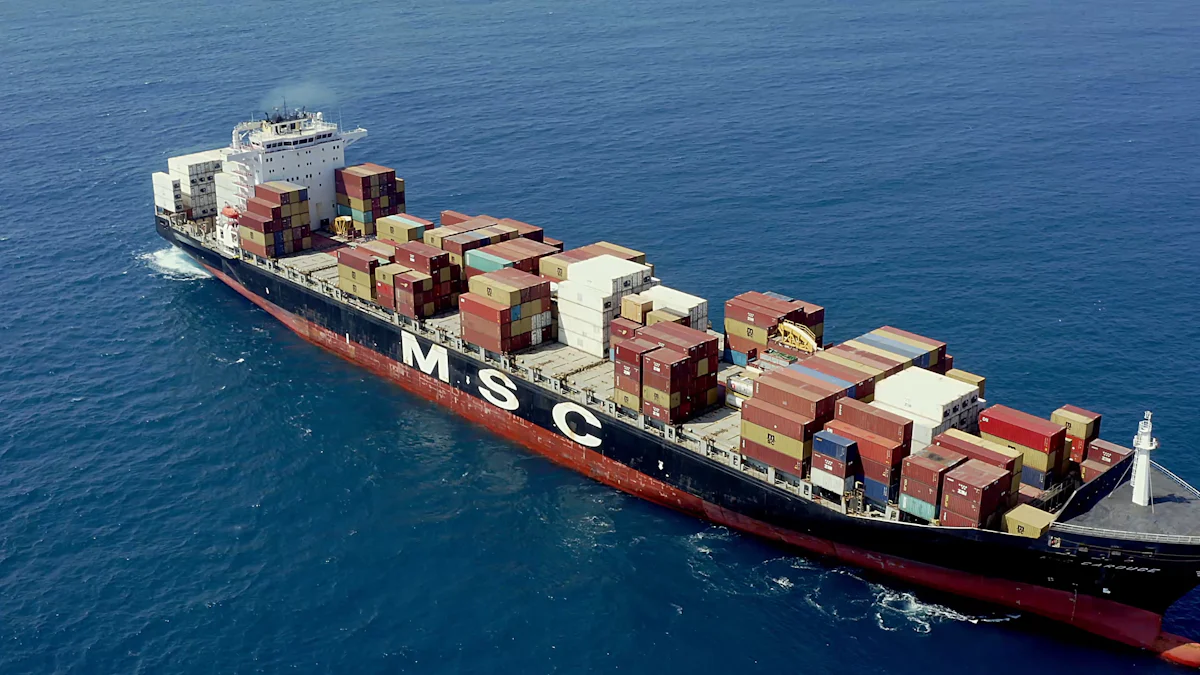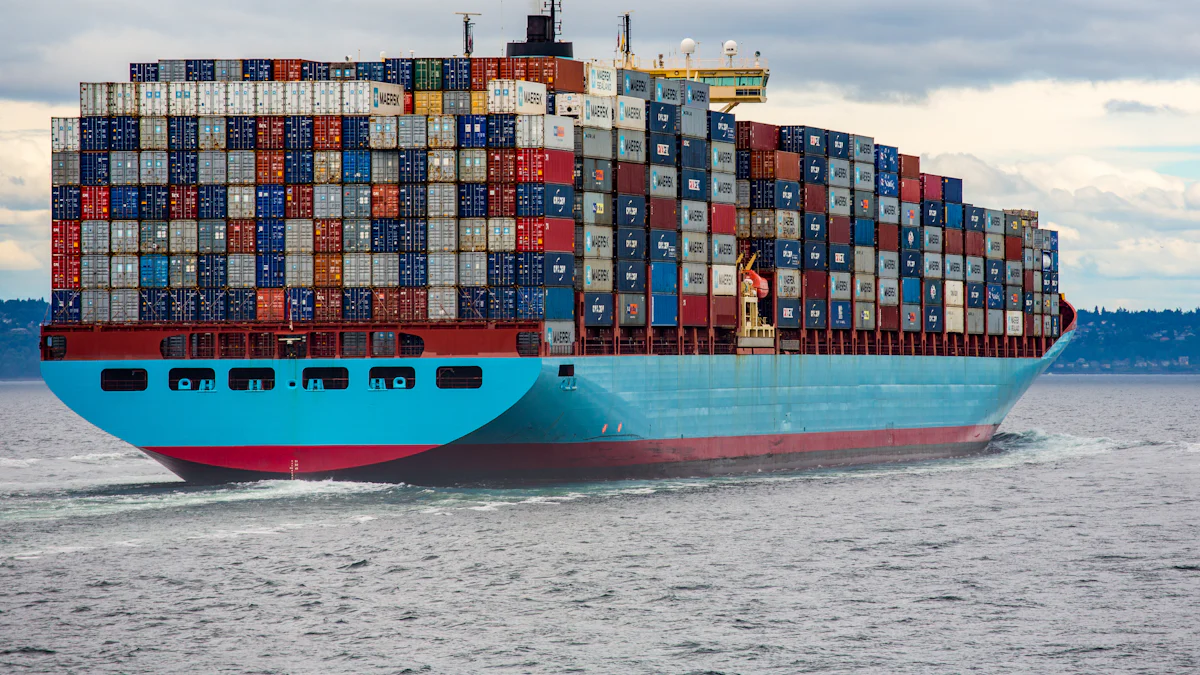Ocean Freight Market: Future Dynamics and Industry Forecast

The Ocean Freight Market plays a crucial role in global trade, facilitating the movement of goods across continents. Understanding market dynamics and future forecasts is essential for stakeholders to make informed decisions. The purpose of this blog post is to provide an in-depth analysis of the current state, influencing factors, emerging trends, and future projections of the ocean freight industry.
Current State of the Ocean Freight Market
Market Overview
Key Players
The Ocean Freight Market features several dominant players who shape industry dynamics. Companies such as Maersk, MSC, and CMA CGM lead the market with extensive global networks. These key players offer comprehensive shipping services, ensuring the efficient movement of goods across continents. The competitive landscape remains fragmented, with many smaller firms vying for market share. This competition drives innovation and service improvements, benefiting customers.
Market Size and Growth
The Ocean Freight Market has experienced significant growth in recent years. In 2021, the market size reached USD 72,600.24 million. Projections indicate a continued expansion at a compound annual growth rate (CAGR) of 3.09% from 2024 to 2032. Factors contributing to this growth include increased global trade volumes and advancements in shipping technologies. The market is expected to reach a value of approximately USD 88.6 billion by 2032. This growth underscores the importance of ocean freight in global logistics.
Recent Developments
Technological Advancements
Technological advancements play a crucial role in the evolution of the Ocean Freight Market. The integration of artificial intelligence (AI) and big data analytics enhances supply chain management. AI processes vast amounts of data in real-time, optimizing routes and predicting demand patterns. Innovations such as blockchain technology improve transparency and security in shipping transactions. These advancements contribute to increased efficiency and reduced operational costs.
Regulatory Changes
Regulatory changes significantly impact the Ocean Freight Market. Governments worldwide implement policies to enhance environmental protection and sustainability. New regulations mandate the reduction of carbon emissions from shipping activities. Compliance with these regulations requires companies to adopt greener practices and invest in eco-friendly technologies. These changes align with global efforts to combat climate change and promote sustainable development in the maritime industry.
Challenges and Opportunities
Supply Chain Disruptions
Supply chain disruptions pose significant challenges to the Ocean Freight Market. Events such as the COVID-19 pandemic highlighted vulnerabilities in global supply chains. Port congestions, labor shortages, and transportation delays disrupt the flow of goods. Companies must develop strategies to enhance supply chain resilience and mitigate risks. Investments in digitalization and automation can help address these challenges and ensure smoother operations.
Environmental Concerns
Environmental concerns drive the need for sustainable practices in the Ocean Freight Market. The shipping industry faces pressure to reduce its carbon footprint and minimize environmental impact. Companies adopt green shipping practices, such as using alternative fuels and energy-efficient vessels. Initiatives like the International Maritime Organization's (IMO) regulations on sulfur emissions aim to reduce pollution from ships. Embracing sustainability not only benefits the environment but also enhances the industry's reputation and competitiveness.
Influencing Factors
Economic Factors
Global Trade Patterns
Global trade patterns significantly influence the Ocean Freight Market. Trade volumes between major economies like the United States, China, and the European Union dictate shipping demand. Changes in trade agreements or tariffs can alter these patterns. For instance, the U.S.-China trade war affected shipping routes and volumes. Companies must monitor these patterns to adapt their logistics strategies effectively.
Currency Fluctuations
Currency fluctuations impact the cost of ocean freight services. Exchange rates between major currencies like the USD, EUR, and CNY affect shipping costs. For example, a stronger U.S. dollar can make imports cheaper but exports more expensive. Companies must hedge against currency risks to maintain stable pricing. Understanding these fluctuations helps in budgeting and financial planning.
Political Factors
Trade Policies
Trade policies play a crucial role in shaping the Ocean Freight Market. Governments implement policies that can either facilitate or hinder international trade. Tariffs, quotas, and trade agreements directly impact shipping volumes. For example, the North American Free Trade Agreement (NAFTA) boosted trade between the U.S., Canada, and Mexico. Companies must stay informed about policy changes to navigate regulatory landscapes effectively.
Geopolitical Tensions
Geopolitical tensions create uncertainties in the Ocean Freight Market. Conflicts and political instability can disrupt shipping routes and increase freight rates. Events like the ongoing conflict in the Red Sea have caused port congestion and delays. Companies must develop contingency plans to mitigate risks associated with geopolitical events. Understanding these tensions helps in making informed decisions about route planning and risk management.
Technological Factors
Automation and Digitalization
Automation and digitalization revolutionize the Ocean Freight Market. Technologies like AI and big data analytics optimize supply chain management. AI processes vast amounts of data in real-time, improving route planning and demand forecasting. Digital platforms enhance transparency and efficiency in shipping transactions. Companies investing in these technologies gain a competitive edge through improved operational efficiency.
Innovations in Shipping
Innovations in shipping drive the evolution of the Ocean Freight Market. Developments in vessel design and propulsion systems enhance fuel efficiency and reduce emissions. The adoption of alternative fuels like LNG (liquefied natural gas) contributes to greener shipping practices. Blockchain technology improves security and transparency in shipping documentation. Companies embracing these innovations can achieve cost savings and meet sustainability goals.
Emerging Trends

Sustainability Initiatives
Green Shipping Practices
Green shipping practices have gained traction in the ocean freight market. Companies now prioritize reducing carbon emissions and enhancing environmental protection. The International Maritime Organization (IMO) has introduced regulations to lower sulfur emissions from ships. Compliance with these regulations requires investment in eco-friendly technologies. Companies adopting green shipping practices can improve their reputation and competitiveness.
Alternative Fuels
The shift towards alternative fuels marks a significant trend in the industry. Liquefied natural gas (LNG) and biofuels offer cleaner alternatives to traditional marine fuels. These fuels help reduce greenhouse gas emissions and other pollutants. Companies investing in alternative fuels can meet regulatory requirements and achieve sustainability goals. The adoption of these fuels also aligns with global efforts to combat climate change.
Market Consolidation
Mergers and Acquisitions
Mergers and acquisitions (M&A) play a crucial role in market consolidation. Key players seek to expand their market share through strategic acquisitions. These moves enhance operational efficiency and service offerings. For instance, major shipping companies have acquired smaller firms to strengthen their global networks. M&A activities drive innovation and improve service quality in the ocean freight market.
Strategic Alliances
Strategic alliances have become a common practice among ocean freight companies. Collaborations between firms help optimize resources and expand service capabilities. Alliances allow companies to offer more comprehensive shipping solutions. Joint ventures and partnerships enable access to new markets and customer segments. These alliances stimulate market demand and foster competitive advantages.
Customer-Centric Approaches
Enhanced Customer Service
Enhanced customer service has emerged as a key focus area. Companies now prioritize meeting customer needs and expectations. Personalized services and real-time tracking options enhance customer satisfaction. Digital platforms provide customers with greater transparency and control over shipments. Improved customer service helps build long-term relationships and loyalty.
Customized Solutions
Customized solutions cater to the unique requirements of different customers. Companies offer tailored shipping options to address specific needs. Specialized services include temperature-controlled transportation and expedited shipping. Customized solutions help companies differentiate themselves in a competitive market. These offerings enhance customer experience and drive business growth.
Future Projections

Market Growth Forecast
Short-term Projections
The Ocean Freight Market is poised for moderate growth in the short term. The market size, valued at USD 74,901.67 million in 2023, is projected to expand at a compound annual growth rate (CAGR) of 3.09%. By 2025, the market is expected to reach approximately USD 78,500 million. This growth will be driven by increasing global trade volumes and technological advancements in shipping.
Long-term Projections
Long-term projections indicate sustained growth for the Ocean Freight Market. By 2032, the market is anticipated to reach USD 89,906.44 million. Factors contributing to this growth include the adoption of sustainable practices, advancements in digitalization, and the expansion of global trade routes. The industry's focus on efficiency and environmental sustainability will play a crucial role in driving long-term growth.
Potential Disruptions
Technological Disruptions
Technological disruptions will significantly impact the Ocean Freight Market. The integration of artificial intelligence (AI) and big data analytics will revolutionize supply chain management. AI will enable real-time data processing, optimizing routes and predicting demand patterns. Blockchain technology will enhance transparency and security in shipping transactions. Companies must invest in these technologies to stay competitive.
Economic and Political Uncertainties
Economic and political uncertainties pose potential risks to the Ocean Freight Market. Geopolitical tensions and trade policy changes can disrupt shipping routes and increase costs. Currency fluctuations will affect pricing and profitability. Companies must develop contingency plans to mitigate these risks. Monitoring global economic indicators and political developments will be essential for strategic planning.
Strategic Recommendations
Investment Opportunities
Investment opportunities abound in the Ocean Freight Market. Companies should focus on technological innovations such as AI, blockchain, and automation. Investments in sustainable practices, including alternative fuels and energy-efficient vessels, will yield long-term benefits. Expanding into emerging markets and optimizing trade routes will enhance service levels and reduce costs.
Risk Mitigation Strategies
Risk mitigation strategies are crucial for navigating the Ocean Freight Market. Companies must diversify their supply chains to enhance resilience. Investing in digitalization and automation will improve operational efficiency. Developing contingency plans for geopolitical and economic uncertainties will help mitigate risks. Regularly reviewing and updating risk management strategies will ensure preparedness for future challenges.
The blog has explored the current state, influencing factors, emerging trends, and future projections of the ocean freight market. Key players like Maersk and MSC lead the industry with extensive networks. Technological advancements and regulatory changes drive market evolution. Supply chain disruptions and environmental concerns present challenges and opportunities.
Staying informed about market dynamics remains crucial for stakeholders. The ocean freight market will continue to evolve with technological integration, sustainability initiatives, and geopolitical influences. Companies that adapt to these trends will thrive in the competitive landscape. The future holds promise for those who embrace innovation and resilience.
See Also
Revealing the Latest in Sea Freight Logistics for 2024
Analyzing the Future of Less Than Truckload Freight
Navigating Future Logistics Using Digital Technology
Understanding the Influence of Logistics Risk Trends
The Transformation of Tomorrow's Logistics with AI in Supply Chain
